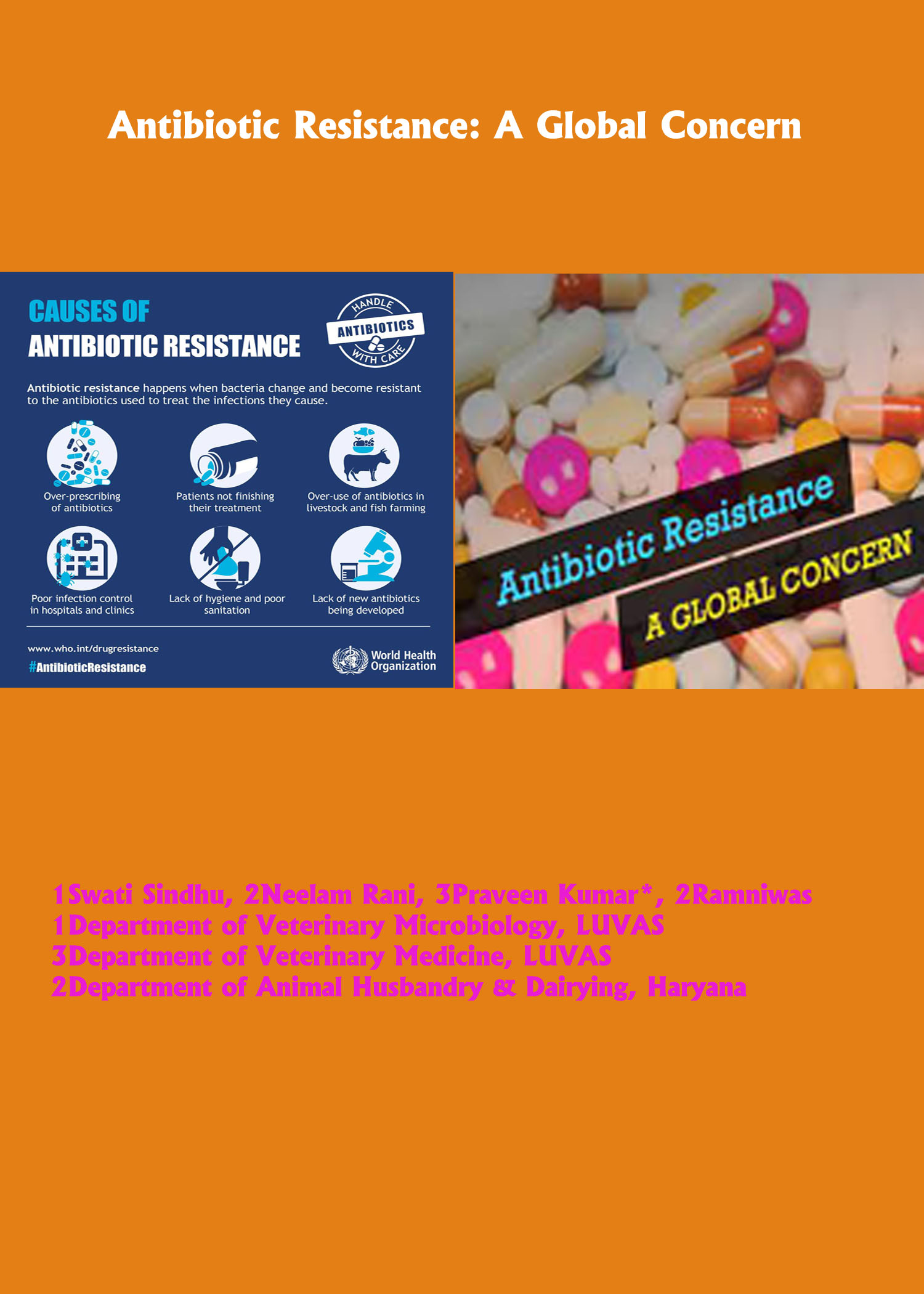Antibiotic Resistance: A Global Concern
1Swati Sindhu, 2Neelam Rani, 3Praveen Kumar*, 2Ramniwas
1Department of Veterinary Microbiology, LUVAS
3Department of Veterinary Medicine, LUVAS
2Department of Animal Husbandry & Dairying, Haryana
*Corresponding author: praveensangwan11192@gmail.com (7988982780, 9812954983)
Introduction
Antibiotics played an unexampled role in social and medical development. Antibiotics have saved life of millions of people. Since years, antibiotics have been used for therapeutic as well as prophylactic purposes. The period from the 1950s to 1970s was considered as the golden era for the discovery of novel antibiotics. The beginning of ‘modern antibiotic era’ was synonymously associated with Alexander Fleming and Paul Ehrlich. Fleming was the first who cautioned regarding penicillin resistance; if used less than prescribed dose. The irresponsible use of antibiotics has contributed significantly to the advent of resistant strains. However, the approach in fighting against the diseases is now diverted on the modification of existing antibiotics to combat emerging and re-emerging micro-organism resistance. Non-judicial use of antibiotics is mostly responsible for antibiotic resistant strains. The antibiotic treatment for drug-resistant bacterial infections is limited, resulting in high morbidity and mortality rate. This article focuses on causes of antibiotic resistance, consequences and future interventions.
Occurrence of antibiotic resistance
Antibiotics are usually effective against microbes, but when the microbes become less sensitive or resistant, it requires a higher than normal concentration of the same drug to produce that effect. Resistant bacteria multiply even in the presence of therapeutic levels of the antibiotics. Antibiotic resistance has been documented even before the usage of antibiotics in treatment. Methicillin was the first of the semisynthetic penicillinase-resistant penicillin to act against penicillinase-producing Staphylococcus aureus strains. Further, although fluoroquinolones were introduced for the treatment of Gram-negative bacterial infections in the 1980s, later found less sensitive or resistant strains against fluoroquinolones also.
Drivers for transmission of antibiotic resistance
Natural selection is not the only mechanism by which resistance evolves as resistance may also be transferred through plasmid transfer between bacteria. It has been reported that the level of antibiotic resistant infections and concentration of antibiotic consumption are positively correlated. Antibiotics used in agriculture and for treatment purpose are often similar. The use of antibiotics as growth promoters for large animals, pigs and poultry could cause antibiotic resistance and further transmission to animals and humans through the network of food chain. The food chain can be considered as the main route of antibiotic resistant strain transmission to animal and human populations. Antibiotic resistance may also likely to occur if full course of prescribed antibiotic treatment is not followed.
Consequences of antibiotic resistance
Antibiotic resistance is not only a laboratory oriented concern but a global threat responsible for life-threatening infections. World Health Organization (WHO) has warned that a post-antibiotic era may result in infections which lead to death if action against antibiotic resistance not taken. There is no scope to ignore global antibiotic resistance. It has been reported that more than 63,000 patients from United States of America (USA) die every year from hospital-acquired bacterial infections. In Europe, an estimated 25,000 patients die every year due to multiple drug resistance (MDR) bacterial infections in Europe. Regulation and control strategies are not in proper place; antibiotic resistance needs to be targeted at a global level. Developing nations are at the greatest risk. Low prices of antibiotics, easy availability and non-judicial use of antibiotics are responsible for this problem to increase mainly in developing countries. In the developing countries, antibiotic resistant strains causes clinical, economic losses and loss of life. Irrational use of drugs has become a major concern.
Future interventions
A number of important organizations, like the Centers for Disease Control and Prevention (CDC), Infectious Diseases Society of America, World Economic Forum and the World Health Organization (WHO) have declared antibiotic resistance to be a “global public health concern”. Treatments for bacterial infections are becoming difficult. Treatment failure is common due to antibiotic resistance and multi-drug resistance. Currently, novel and effective antibiotics are in high demand. Also, passive immunization to prevent bacterial infections have been found effective. Another effective intervention is phage therapy, where bacteriophages are used to treat bacterial infections. Many of antimicrobials to fight antibiotic resistance are in the pipeline for clinical trials. These strategies are aimed not only at targets but rather at the biological networks that may help to create new antibacterial treatment. Organ transplantation, advanced level surgeries, cancer treatment might not have been possible without effective antibiotic treatment. If effective global action plans to combat antibiotic resistance are not adopted soon, then we might encounter complications.
Conclusion
Resistance to an antibiotic develops in no time so it is a matter of concern. With the improvement of technology, more people are now aware of the ill-effects of antibiotic resistance. In the developing world, almost all the antibiotics are available over the counter and can be bought without any medical prescription sometimes. The occurrence of antibiotic resistance is multifaceted, and its consequences pose a threatening global impact. A number of attempts have been made to delineate the diverse aspects of antibiotic resistance. However, mainstream coordinated approach is lacking. Therefore, if the resistance to the antibiotics needs to be curbed, the way shall be to aware the general public, completion of prescribed dosage schedule, judicial use of antibiotics and a well coordinated approach to tackle antibiotic resistance is required.



